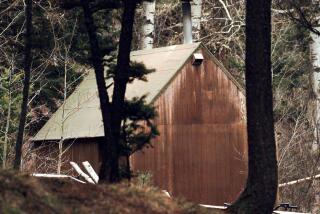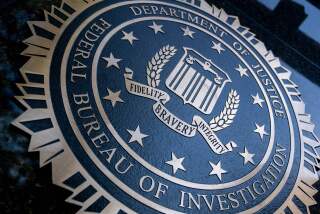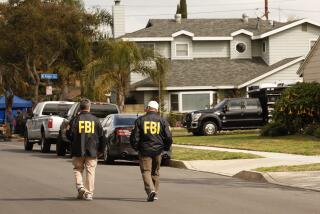Kaczynski’s Cabin Was Lab for Bombs, Prosecutors Say
SACRAMENTO — Unabomber suspect Theodore J. Kaczynski’s small Montana cabin served as a bomb-making “laboratory” where authorities found extensive evidence linking him to other explosive devices, not just the four used in bombings for which he was indicted, federal prosecutors said Monday.
To build their case against Kaczynski, prosecutors asked U.S. District Judge Garland E. Burrell in Sacramento to allow introduction of evidence of bombings since 1978 to show that Kaczynski was the Unabomber.
The four bombings with which he is charged “formed part of an 18-year scheme in which the defendant mailed or placed 16 bombs in an effort, as Kaczynski himself phrased it, to ‘kill someone I hate,’ ” said Assistant U.S. Atty. Robert Cleary in a filing made available to reporters.
In seeking to persuade Burrell, the government added new details to its case against the 55-year-old, Harvard-educated mathematician, and began to unravel the mystery of how someone acting alone with little money could have delivered the bombs.
Evidence tying Kaczynski to the string of bombings included handwritten journals, letters to several of his victims and other messages, most of them written on a typewriter seized at the shack when he was arrested in April 1996.
Cleary said that beginning in the late 1970s, Kaczynski recorded details of his first bombings and continued “memorializing his bombing activities,” which he sometimes characterized as experiments. Prosecutors said he wrote down many of the experiments in informal “lab notes” that covered more than 1,000 pages.
Moreover, various materials seized in the cabin were used to make and package bombs, including “a unique pivot switch.” And, in what the government calls perhaps its most compelling “other act” evidence, a fully constructed 17th bomb seized at the cabin was “substantially similar” to one that in 1995 killed Sacramento timber industry executive Gilbert B. Murray.
“The cabin bomb was constructed by filling a 3/8-inch-diameter copper tube with an explosive charge and placing the copper tube, along with additional explosive powder, inside of a larger, homemade lead pipe,” government attorneys said.
Nearly a year ago, Kaczynski was indicted on 10 bomb-related offenses, including blasts that killed Murray and Hugh Scrutton, a Sacramento computer store owner, and injured two university professors. Kaczynski, who remains in custody in the Sacramento County Jail, has pleaded not guilty and is scheduled to stand trial in November. Kaczynski also has been charged in a New Jersey blast that killed advertising executive Thomas J. Mosser.
While defense lawyers in Sacramento have argued that their client’s “aversion to traveling” was one factor that weighed against him being the Unabomber, prosectors contend that a review of all the blasts will offer “an explanation of how Kaczynski managed to obtain the opportunity to commit the charged bombings only by stretching his tight financial resources and by traveling to different cities to send or place the bombs.”
Prosecutors quoted Kaczynski as writing in his journal, in describing a 1982 bombing at UC Berkeley, “Traveling expenses for raids such as the foregoing are very hard on my slender financial resources.”
At another point, describing an attempted bombing at the University of Utah Business School, Kaczynski allegedly wrote: “Last fall I attempted a bombing and spent nearly 300 bucks just for travel expenses, motel, clothing for disguise, etc. Aside from cost of materials for the bomb. And then the thing failed to explode. Damn.”
The journals contain extensive discussions of Kaczynski’s ideology, motivations and expressions of his “intent to kill his victims,” according to prosecutors.
“Briefly stated, Kaczynski despised anyone who interfered with the solitude that he craved and he harbored a deep-seated hatred of certain aspects of modern technological and industrial society,” prosectors wrote.
Parts of their motion were deleted from the copies distributed to news organizations, but the complete version was to be filed under seal with the court.
Kaczynski’s lawyers argued in their own filing that “there is a substantial probability of irreparable damage” to their client’s “fair trial rights” from a public filing of this sensitive material.
Defense attorney Quin Denvir could not be reached for comment.
Government attorneys have asked for a July 11 hearing to admit the evidence.
More to Read
Sign up for Essential California
The most important California stories and recommendations in your inbox every morning.
You may occasionally receive promotional content from the Los Angeles Times.










